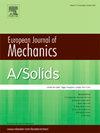Projectile impact behavior of drop-stitch inflatables
IF 4.4
2区 工程技术
Q1 MECHANICS
引用次数: 0
Abstract
The response of drop-stitch inflatable panels to low-velocity projectile impacts was experimentally investigated. Projectile interaction with the specimen and the back face specimen deformation was recorded using high-speed imaging, and the back face deformations of the specimen was analyzed using digital image correlation technique. The strain energy in the inflatable membrane (back face) was also estimated using the full-field strain data. Analysis of the impact response of inflatables suggests several ways to control the back face deflection for any given load, as well as the importance of boundary conditions to the deflection behavior and energy distribution within the inflatable. Experimental results revealed a strong interplay of specimen thickness and internal pressure, and overall thicker inflatable panels exhibit lesser deflection. For six-fold increase in the internal pressure, the deflection decreased by 40 % in thicker inflatables and by up to 28 % in thin panels. At 206.8 kPa internal pressure, thick inflatable panels showed up to 28 % lesser deflection than the thin inflatables. Energy analysis revealed the significant role of sliding friction in dissipating large amounts of input energy, between 50 and 75 % of the input being lost. Furthermore, the jump in strain energy from impact increases with higher internal pressures.
求助全文
约1分钟内获得全文
求助全文
来源期刊
CiteScore
7.00
自引率
7.30%
发文量
275
审稿时长
48 days
期刊介绍:
The European Journal of Mechanics endash; A/Solids continues to publish articles in English in all areas of Solid Mechanics from the physical and mathematical basis to materials engineering, technological applications and methods of modern computational mechanics, both pure and applied research.

 求助内容:
求助内容: 应助结果提醒方式:
应助结果提醒方式:


